Looking for a tree that’s as sharp as it is beautiful? Look no further than Acer palmatum, commonly known as Japanese maple. This deciduous tree, part of the Sapindaceae family, originates from Japan, Korea, and China and grows up to 6-10 meters in height. The leaves are hand-shaped and come in a variety of colors like green, red, orange, and purple.
But don’t let its delicate appearance fool you – the name “Acer” means sharp or pointed in Latin! With its striking foliage and attractive shape, it’s no wonder why Japanese maple is a popular ornamental tree.
So if you’re looking to add some color and personality to your garden or landscape design, consider adding an Acer palmatum to the mix!
Characteristics and Features of Japanese Maple
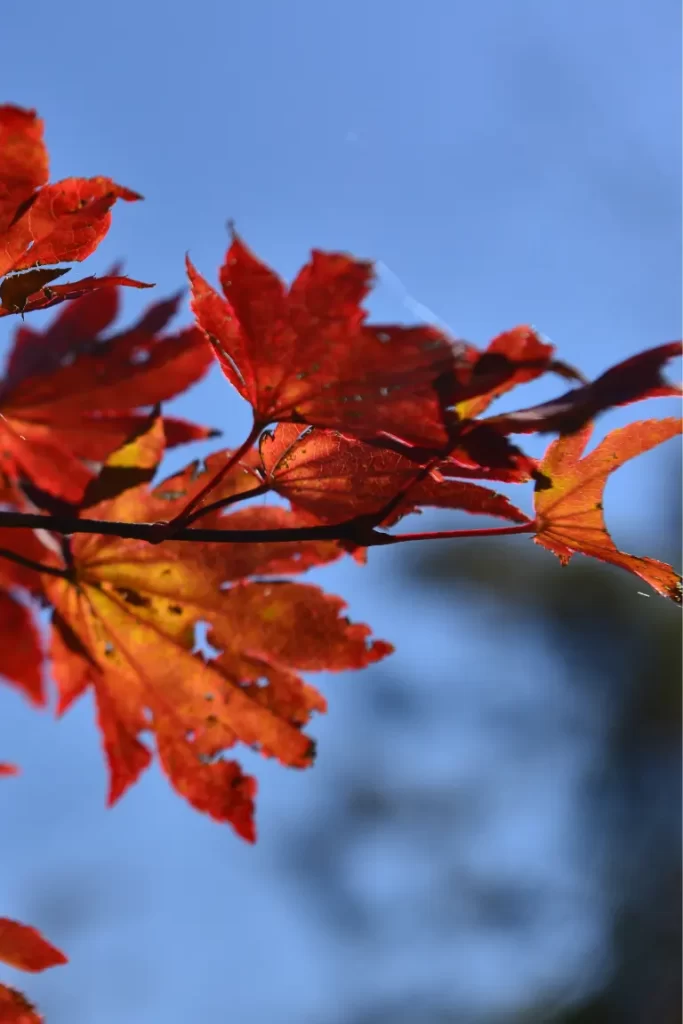
Japanese maple (acer palmatum) is a stunning deciduous tree that can grow up to 25 feet tall. It has several unique features that make it a popular ornamental tree in gardens and parks around the world.
Unique Leaf Shape and Colors
One of the most striking features of the Japanese maple is its leaves. They have a distinctive shape with pointed lobes and serrated edges. The leaves come in a variety of colors, including red, green, and purple. Some varieties even have variegated leaves with multiple colors on one leaf.
Small Flowers and Winged Seeds
In the spring, Japanese maples produce small, inconspicuous flowers that are not particularly showy. However, these flowers give way to winged seeds in the fall that add interest to the tree’s appearance.
Popular Ornamental Tree
Japanese maples are highly sought after for their striking appearance and ability to thrive in a variety of climates. They are often used as focal points in gardens or planted en masse for added impact.
Growing Requirements
To grow successfully, Japanese maples require well-drained soil and partial shade. They do not tolerate wet conditions or full sun exposure well. When planting a Japanese maple, be sure to choose a location that provides enough shade during the hottest part of the day.
Choosing a Japanese Maple
When choosing a Japanese maple for your garden or landscape, there are several factors to consider:
- Size: Consider how much space you have available for your tree to grow.
- Color: Choose a color that complements your existing landscape design.
- Form: Decide whether you want an upright or weeping form.
- Hardiness: Make sure you choose a variety that is hardy enough for your climate zone.
When Do Leaves Turn Red?
Many people wonder when their Japanese maple’s leaves will turn red. The answer depends on several factors, including the variety of tree, climate conditions, and soil moisture levels. In general, Japanese maples tend to turn red in the fall as temperatures cool down. However, some varieties may also exhibit red leaves in the spring or summer.
Different Cultivars and Variations of Japanese Maple
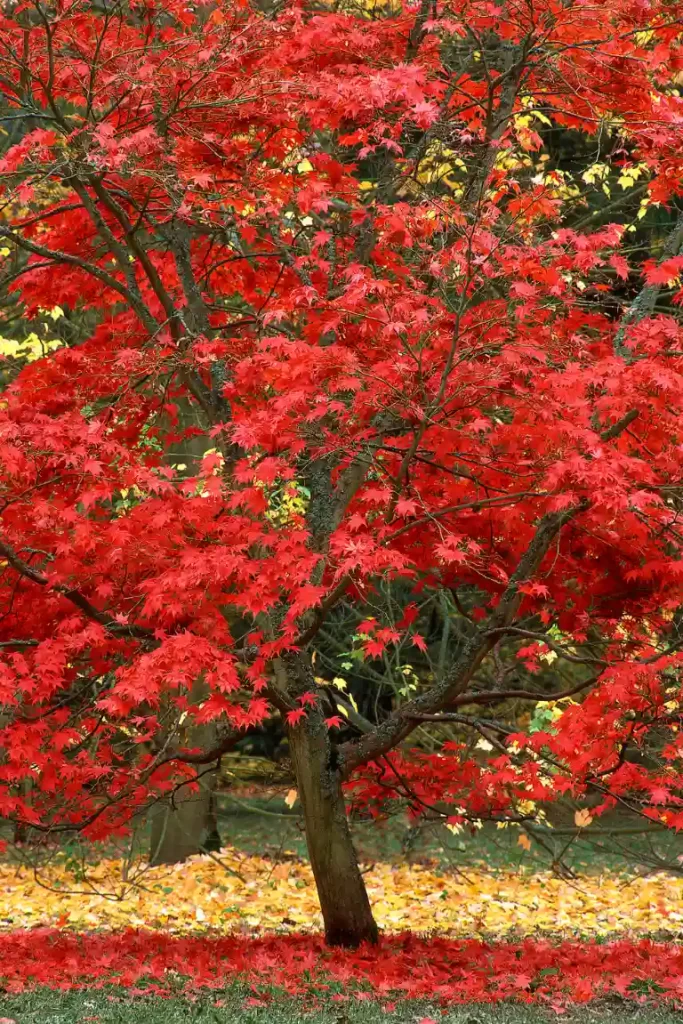
Japanese maple (Acer palmatum) is a popular ornamental tree known for its stunning foliage, delicate branches, and graceful form. With over 1,000 cultivars available worldwide, this species offers an incredible range of colors, shapes, sizes, and textures that can suit any garden style or preference.
Types of Japanese Maples
There are several types of Japanese maples to choose from, each with its unique characteristics:
- Palmatum Group: This group includes most of the popular cultivars of Japanese maple trees. They have five to seven lobes on their leaves and come in various colors ranging from green to red to purple.
- Dissectum Group: These maples have deeply cut leaves that give them a lacy appearance. They come in various shades of green and red and are often used as accent plants or groundcovers.
- Matsumurae Group: This group has broader leaves than the Palmatum Group but still retains the classic shape. They come in various shades of green and red.
- Aureum Group: These maples have yellow-green foliage that turns golden yellow in autumn.
Popular Cultivars
Some popular cultivars of Japanese maple include:
- Bloodgood: This is one of the most popular cultivars due to its deep burgundy-red leaves that hold their color well throughout the season.
- Emperor I: This cultivar has bright green leaves that turn orange-red in autumn. It also has a more upright growth habit than other varieties.
- Sango-kaku (Coral Bark): This cultivar is known for its vibrant coral-red bark that stands out during winter months when other trees are dormant.
- Beni Kawa (Crimson River): This variety has bright red bark with small green leaves that turn yellow-orange in fall.
Unique Branch Patterns
Some cultivars of Japanese maple are known for their unique branch patterns or multiple trunks, making them a popular choice as a specimen tree. For example:
- Shishigashira (Lion’s Head): This cultivar has a dense, compact growth habit with twisted branches that resemble a lion’s mane.
- Katsura: This variety has an unusual vase-like shape with multiple stems that create a layered effect.
- Ukigumo (Floating Clouds): This cultivar has variegated leaves with white and pink edges that give the appearance of floating clouds.
Seedling Variations
Japanese maple seedlings can produce variations that are not found in the parent species, leading to even more cultivars being developed. These variations can result from natural mutations or cross-pollination between different varieties. Some gardeners enjoy growing seedlings to see what unique characteristics they may develop.
Size Variations
The trunk size of Japanese maples can vary greatly depending on the cultivar, with some reaching up to 25 feet tall while others remain small and compact. Some smaller varieties include:
- Acer palmatum ‘Atropurpureum’: This is a dwarf variety that grows only three to six feet tall.
- Acer palmatum ‘Shaina’: This is another dwarf variety with bright red foliage that grows only five feet tall.
Japanese Maple Collections
Japanese maple collections can include a range of cultivars, allowing for a variety of shades and colors throughout the year. A collection can also showcase how different varieties complement each other in terms of leaf shape, size, and color. Many botanical gardens feature Japanese maple collections as part of their landscape design.
Growing Conditions for Japanese Maple
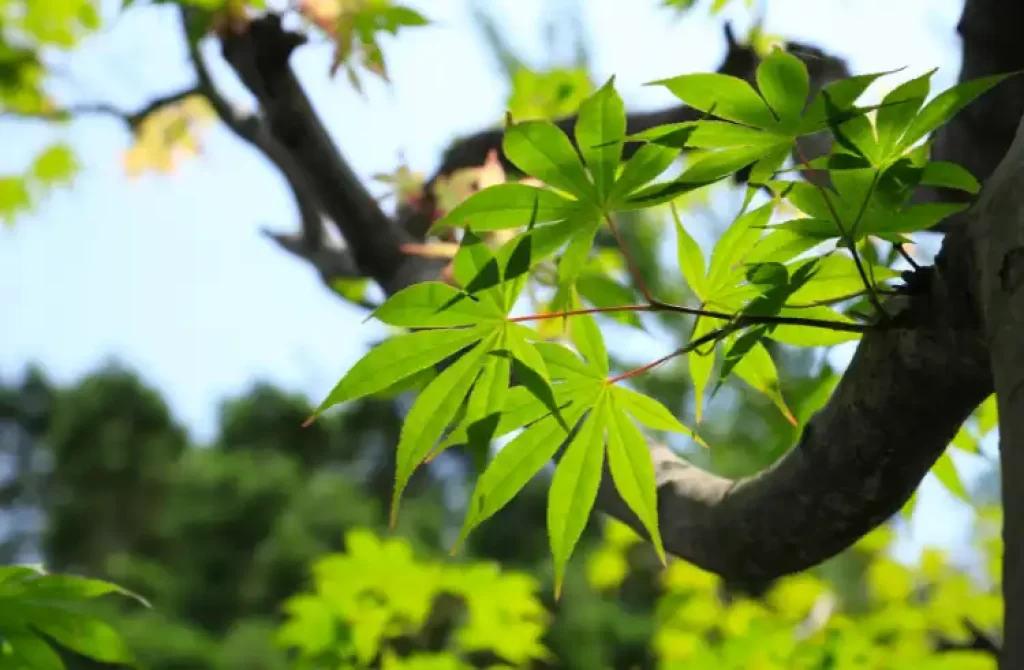
Japanese maple (Acer palmatum) is a stunning ornamental tree that can add beauty to any landscape. However, it requires specific growing conditions to thrive and reach its full potential. Here are some essential things you need to know about the growing conditions for Japanese maple:
Soil and Sunlight Requirements
Japanese maple prefers well-drained soil that is rich in organic matter. It needs consistent moisture but cannot tolerate standing water or overly wet soil. Therefore, it’s best to plant Japanese maple in a spot with good drainage.
Japanese maple prefers partial shade or filtered sunlight. Direct sunlight can scorch the leaves and cause damage to the tree. If you live in an area with hot summers, consider planting your Japanese maple where it receives morning sun and afternoon shade.
Growth Rate and Habit
The growth rate of Japanese maple is slow to moderate – typically 1-2 feet per year. The growth habit of Japanese maples is usually upright and spreading, with a rounded canopy that provides excellent shade during the summer months.
Watering Needs
As mentioned earlier, consistent moisture is crucial for the health of Japanese maples. During the first few years of growth, make sure to water your tree regularly – at least once a week if there’s no rain. Once established, you can reduce watering frequency but still ensure that the soil stays moist.
Container Gardening
Japanese maples can be grown in containers as long as they have enough space for their roots to grow. However, container-grown trees require more attention than those planted directly in the ground. You’ll need to water them more frequently and fertilize them regularly during the growing season.
Pruning
Pruning is an essential part of maintaining healthy and attractive Japanese maples. It helps control their size and shape while promoting new growth and improving overall structure.
If you’re new to pruning, it’s best to start with light pruning and gradually work your way up. You can prune Japanese maples in late winter or early spring before new growth appears.
Common Problems
Japanese maples are generally hardy trees, but they can be susceptible to certain problems. Drought stress is a common issue that can cause leaf scorching and drop. To avoid this, make sure to water your tree regularly and mulch around the base to retain moisture.
Another problem is verticillium wilt, a fungal disease that affects many species of trees, including Japanese maple. Symptoms include wilting leaves, yellowing foliage, and stunted growth. Unfortunately, there’s no cure for this disease once it infects a tree.
Where to Buy
If you’re looking to buy a Japanese maple tree, there are several options available. You can purchase them from local nurseries or garden centers or order them online from reputable sellers. Make sure to choose a healthy-looking tree with good root structure and plant it in an appropriate spot with the right growing conditions.
Soil, Watering, and Fertilizing Requirements for Japanese Maple
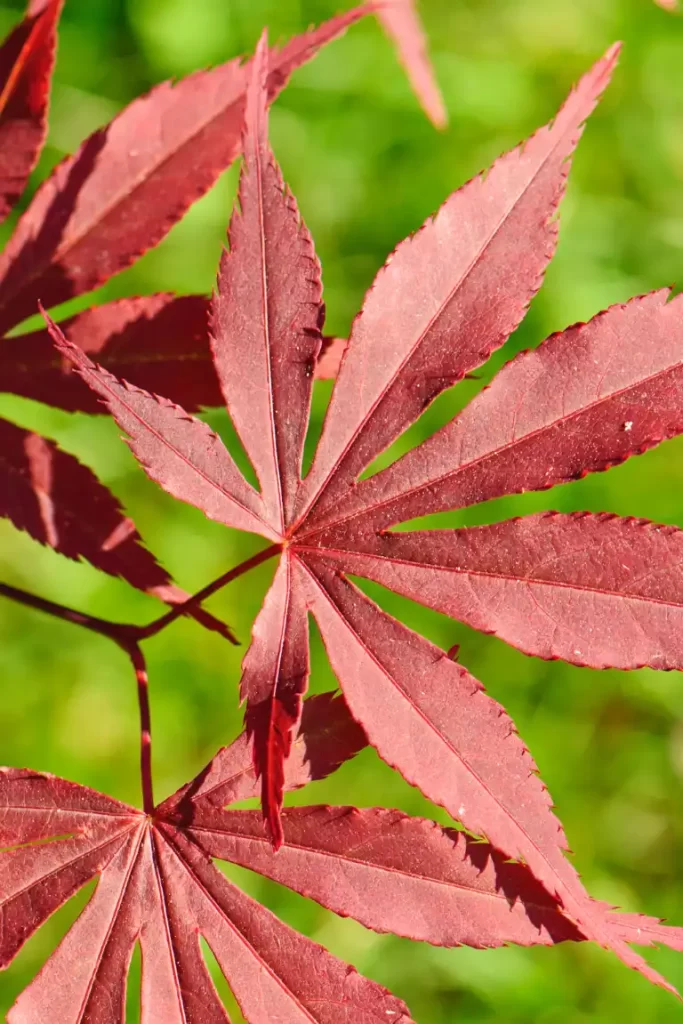
Japanese maple (Acer palmatum) is a stunning ornamental tree that is widely grown in gardens and landscapes. To keep your Japanese maple healthy and thriving, it’s essential to understand its soil, watering, and fertilizing requirements.
Soil Requirements
Japanese maple prefers well-draining soil with a pH range of 5.5 to 6.5. The soil should be rich in organic matter, such as compost or aged manure. These materials help improve soil structure, retain moisture, and provide nutrients to the tree.
It’s crucial to avoid planting Japanese maple in heavy clay soil or soil that retains too much moisture. This can lead to root rot and other fungal diseases that can harm the tree’s health.
Watering Requirements
Watering is critical for the growth and development of Japanese maple trees. During hot and dry weather conditions, it’s essential to water deeply and regularly.
The best way to water your Japanese maple is by using a soaker hose or drip irrigation system. This will ensure that the water reaches the roots without wetting the foliage excessively.
Mulching around the base of the tree can help retain moisture in the soil and regulate temperature. A layer of two to three inches of mulch will also prevent weeds from growing around your tree.
Fertilizing Requirements
Fertilizing your Japanese maple is essential for promoting healthy growth. The best time to fertilize is in early spring when new growth appears on the tree.
Use a slow-release balanced fertilizer with an N-P-K ratio of 10-10-10 or 14-14-14. Apply according to package instructions based on your tree size and age.
Avoid over-fertilizing as this can damage your tree’s roots and cause leaf scorching. It’s better to under-fertilize than over-fertilize your Japanese maple.
Pruning and Training Techniques for Japanese Maple
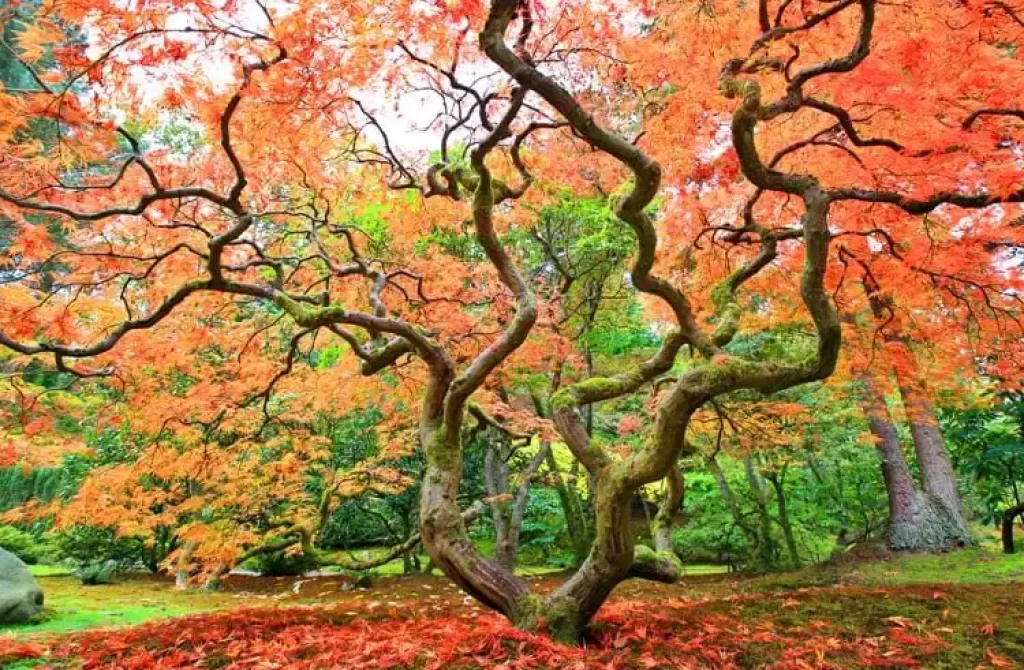
Pruning and training your Japanese maple is essential to promote healthy growth, maintain its desired form, and prevent common problems. In this section, we will discuss the best practices for pruning and training your Japanese maple.
When to Prune Your Japanese Maple
The dormant season is the best time to prune your Japanese maple. This period typically starts in late fall after the leaves have fallen and ends in early spring before new growth appears. Pruning during this time helps avoid damaging the tree’s delicate branches and promotes healthy growth.
How to Prune Your Japanese Maple
When pruning your Japanese maple, it’s important to use clean, sharp tools such as bypass pruners or a handsaw to make precise cuts. Avoid tearing or crushing the branches as this can cause damage that may lead to disease or insect infestation.
Start by removing any dead, diseased, or damaged branches first. Then thin out overcrowded areas by selectively removing some of the smaller branches. This will improve air circulation and sunlight penetration throughout the tree.
Avoid over-pruning your Japanese maple as it can weaken the tree’s structure and affect its overall health. A good rule of thumb is not to remove more than 25% of the tree’s total foliage in one year.
Training Young Japanese Maples
Training young Japanese maples involves selecting a central leader branch that will become the main trunk of the tree while removing competing branches that may grow too close together or at awkward angles.
As your tree grows taller, shape it by selectively pruning back certain branches while leaving others intact. This will help maintain its desired form while promoting healthy growth.
It’s important to note that each variety of Japanese maple has its own unique characteristics and growth habits. Familiarize yourself with your specific variety so you can tailor your pruning techniques accordingly.
Common Problems with Japanese Maples
Japanese maples are generally hardy trees, but they can be susceptible to a few common problems such as:
- Leaf scorch: This occurs when the tree is exposed to too much direct sunlight or dry soil conditions. To prevent leaf scorch, provide your Japanese maple with partial shade and keep the soil moist.
- Verticillium wilt: This is a fungal disease that causes wilting, yellowing, and browning of leaves. There is no cure for verticillium wilt, so prevention is key. Avoid planting your Japanese maple in areas where this disease has been present before.
- Aphids: These tiny insects feed on the sap of the tree’s leaves and can cause stunted growth and distorted foliage. You can control aphid infestations by using insecticidal soap or neem oil.
Common Pests and Diseases of Japanese Maple
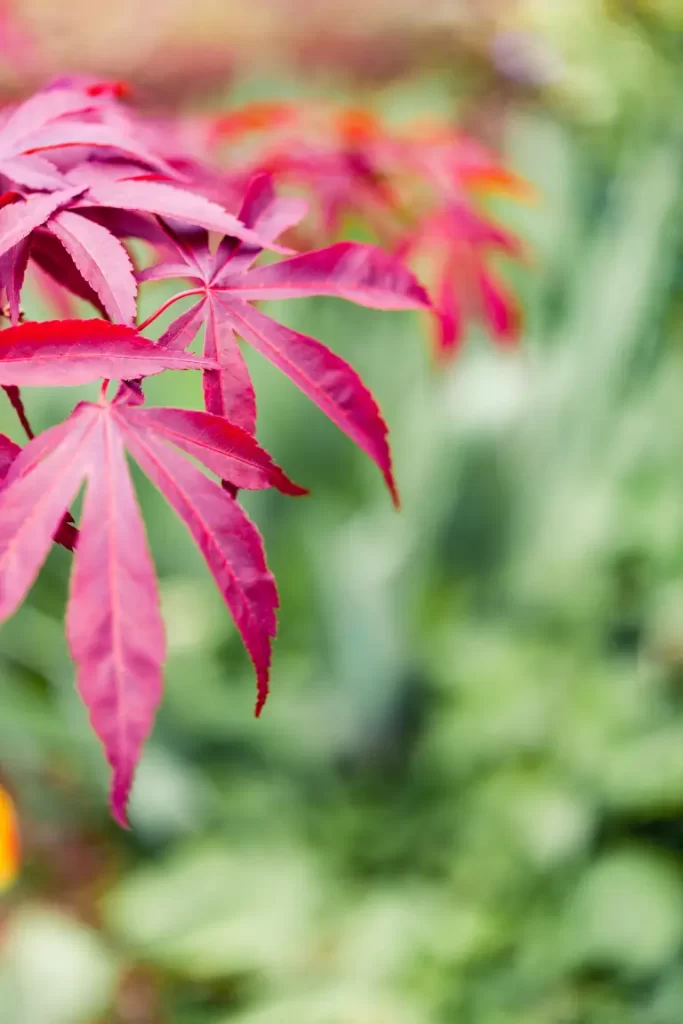
Japanese maple, also known as Acer palmatum, is a beautiful ornamental tree that is native to Japan, Korea, and China. It is prized for its delicate leaves and graceful branching structure. However, like any other plant, it is vulnerable to various pests and diseases that can affect its health and appearance.
Leaf Scorch
Leaf scorch is a common problem that affects Japanese maple trees. It is characterized by the browning of leaf margins or tips due to water stress.
The most common causes of leaf scorch are drought, excessive heat, or root damage. When the tree experiences water stress, it cannot absorb enough moisture from the soil to keep up with transpiration through the leaves. As a result, the leaves dry out and turn brown around the edges.
To prevent leaf scorch in Japanese maple trees, it is important to keep the soil moist but not waterlogged. Mulching around the base of the tree can help retain moisture in the soil and regulate temperature fluctuations. Providing adequate shade during hot summer months can also reduce water loss through transpiration.
Aphids
Aphids are small insects that feed on sap from leaves and stems of plants. They are a common pest in Japanese maple trees and can cause significant damage if left untreated.
Signs of aphid infestation include curled or distorted leaves, sticky residue on leaves or branches (known as honeydew), and black sooty mold growth.
To control aphids in Japanese maple trees, insecticidal soap or neem oil can be applied directly to affected areas. These products work by suffocating or poisoning the insects without harming beneficial predators such as ladybugs or lacewings.
Scale Insects
Scale insects are another type of sap-sucking pest that can infest Japanese maple trees. They secrete a protective shell-like covering over their bodies which makes them difficult to detect and control. Signs of scale insect infestation include yellowing or wilting leaves, stunted growth, and honeydew secretion.
To control scale insects in Japanese maple trees, horticultural oil or neem oil can be applied to the affected areas. These products work by suffocating the insects and disrupting their life cycle.
Powdery Mildew
Powdery mildew is a fungal disease that affects many types of plants, including Japanese maple trees. It is characterized by a white or grayish powdery coating on leaves, stems, and flowers. It thrives in warm, humid conditions and can spread quickly if left untreated.
To prevent powdery mildew in Japanese maple trees, it is important to improve air circulation around the tree by pruning back any dense growth or overcrowded branches. Fungicides such as sulfur or copper-based products can also be used to control powdery mildew.
Verticillium Wilt
Verticillium wilt is a fungal disease that affects the vascular system of plants such as Japanese maple trees. It causes yellowing and wilting of leaves, stunted growth, and eventual death of the tree if left untreated. The fungus enters through the roots and spreads throughout the plant’s vascular system.
To prevent verticillium wilt in Japanese maple trees, it is important to plant resistant cultivars that are less susceptible to the disease. Avoiding stress on the tree such as drought or root damage can also reduce its vulnerability to infection.
How to Propagate Japanese Maple
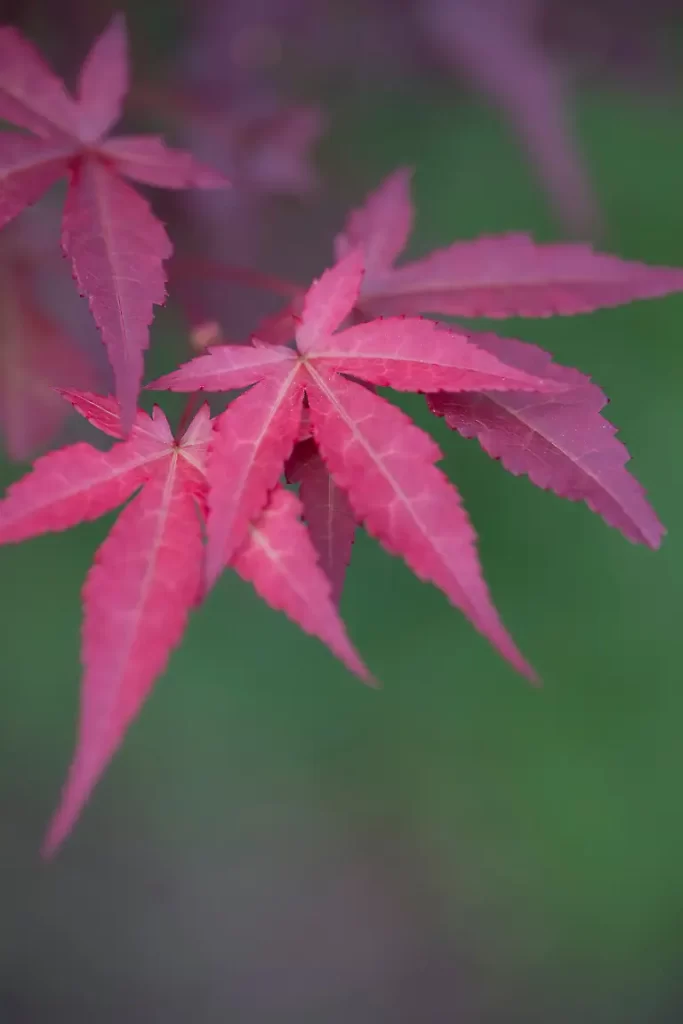
If you’re a fan of the stunning Japanese maple (acer palmatum) and want to propagate it, there are three main methods you can use: seeds, cuttings, or grafting. Each method has its own set of steps and requirements, so let’s dive into how to propagate Japanese maple using each one.
Seeds
To propagate Japanese maple through seeds, you’ll need to collect them in the fall (usually around October). Look for mature seeds that have turned brown and fallen from the tree. Once you’ve collected your seeds, they’ll need to go through a process called stratification before planting in the spring.
Stratification involves keeping your seeds moist and cold for several months. You can do this by placing them in a plastic bag with some damp peat moss or vermiculite and storing them in your refrigerator for 90-120 days. After they’ve been stratified, plant your seeds in a well-draining soil mix about 1/4 inch deep and keep them moist until they germinate.
Cuttings
Propagating Japanese maple through cuttings is best done with softwood cuttings taken in early summer. Look for new growth that is still flexible but has hardened slightly at the base. Cut a section about 6 inches long from the tip of the branch and remove all but the top two leaves.
Dip the end of your cutting into rooting hormone powder and plant it in a well-draining soil mix. Keep your cutting moist by covering it with plastic or placing it under misters until roots have formed.
Grafting
Grafting is another method of propagating Japanese maple that involves attaching a scion from a desired cultivar onto a rootstock of a different species or cultivar. This allows you to create unique combinations of foliage color and shape.
To graft Japanese maple, start by selecting both your scion (the part of the plant you want to propagate) and your rootstock. Make a clean cut on both pieces, then attach them using grafting tape or wax. Keep your grafted plant in a warm, humid environment until it has taken hold.
Benefits of Growing Japanese Maple in Your Garden
Japanese maple, also known as Acer palmatum, is a popular ornamental tree that is highly sought after by gardeners and landscapers. This stunning tree has many benefits that make it an excellent addition to any garden or landscape. In this article, we will discuss the top benefits of growing Japanese maple in your garden.
Adds a Unique and Stunning Visual Appeal to Any Garden or Landscape
One of the most significant benefits of growing Japanese maple in your garden is its unique and stunning visual appeal. The tree’s delicate leaves come in various colors, including red, green, yellow, and purple. Some varieties even have variegated leaves with different shades of color. The tree’s graceful branches add an elegant touch to any landscape design.
Provides Shade and Shelter for Other Plants and Wildlife
Another benefit of growing Japanese maple in your garden is that it provides shade and shelter for other plants and wildlife. The tree’s dense foliage can protect smaller plants from harsh sunlight while providing a habitat for birds and insects.
Can Improve Air Quality by Absorbing Pollutants and Releasing Oxygen
Japanese maple can also improve air quality by absorbing pollutants such as carbon dioxide, sulfur dioxide, and nitrogen oxides from the atmosphere. The tree releases oxygen during photosynthesis, which helps to purify the air around it.
Low Maintenance and Easy to Care for
Japanese maple is low maintenance and easy to care for compared to other trees. It requires minimal pruning, fertilizing, watering, or pest control measures making it an excellent choice for beginner gardeners.
Can Increase Property Value Due to Its Aesthetic Appeal And Rarity
The aesthetic appeal of Japanese maple makes it a valuable addition to any property that can increase its value significantly. Moreover, some rare cultivars are highly prized by collectors who are willing to pay top dollar for them.
Has a Long Lifespan
Japanese maple has a long lifespan, with some trees living for over 100 years. This means that it can provide beauty and shade to your garden for generations to come.
Why Japanese Maple Turning Green? Why Japanese Maple Leaves Turning Green?
It is not uncommon for the leaves of Japanese maple to turn green during the summer months. This is because the tree’s chlorophyll production increases in response to sunlight exposure, which causes the leaves’ color to change from red or purple to green. However, if the leaves remain green throughout the year, it may indicate a nutrient deficiency or an underlying health issue that requires attention.
The Beauty and Care of Acer Palmatum (Japanese Maple)
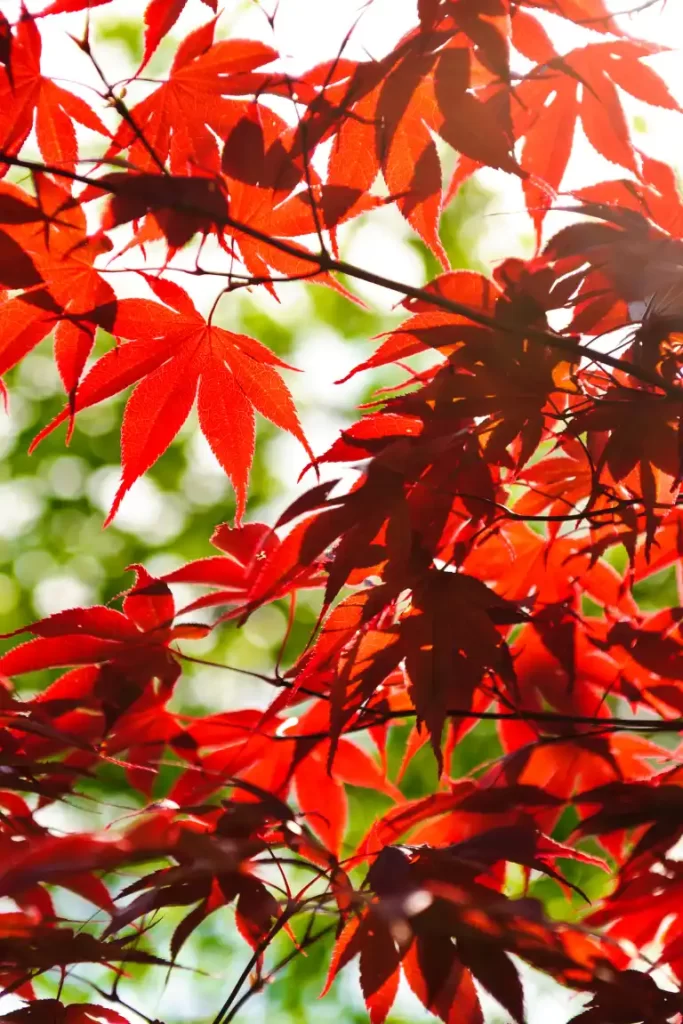
Acer palmatum, also known as Japanese maple, is a stunning tree that can add beauty and elegance to any garden or landscape. Here are some tips on how to care for this beautiful plant:
Planting Acer Palmatum
When planting your Japanese maple, make sure to choose a location with dappled shade or under the canopy of larger trees. This will help protect it from harsh sunlight and keep its leaves healthy and vibrant. It is also important to ensure that the soil is well-draining and rich in organic matter.
Watering and Pruning
Acer palmatum requires regular watering during dry spells, especially during its first few years of growth. However, be careful not to overwater as this can lead to root rot. In terms of pruning, it is best to prune your Japanese maple in late winter or early spring before new growth begins. This will help maintain its shape and encourage healthy growth.
Foliage
The foliage of Acer palmatum is one of its most striking features. Its leaves range in color from bright green to deep purple-red and have a delicate texture that adds to their beauty. During the fall season, this tree puts on a spectacular display of color as its leaves turn shades of red, orange, and yellow before falling off in preparation for winter.
Maintenance
While Acer palmatum is generally easy to care for, it does require regular maintenance to keep it healthy and looking its best. This includes fertilizing once a year with an all-purpose fertilizer in early spring and removing any dead or diseased branches as soon as they appear.
Garden Design Ideas with Japanese Maples
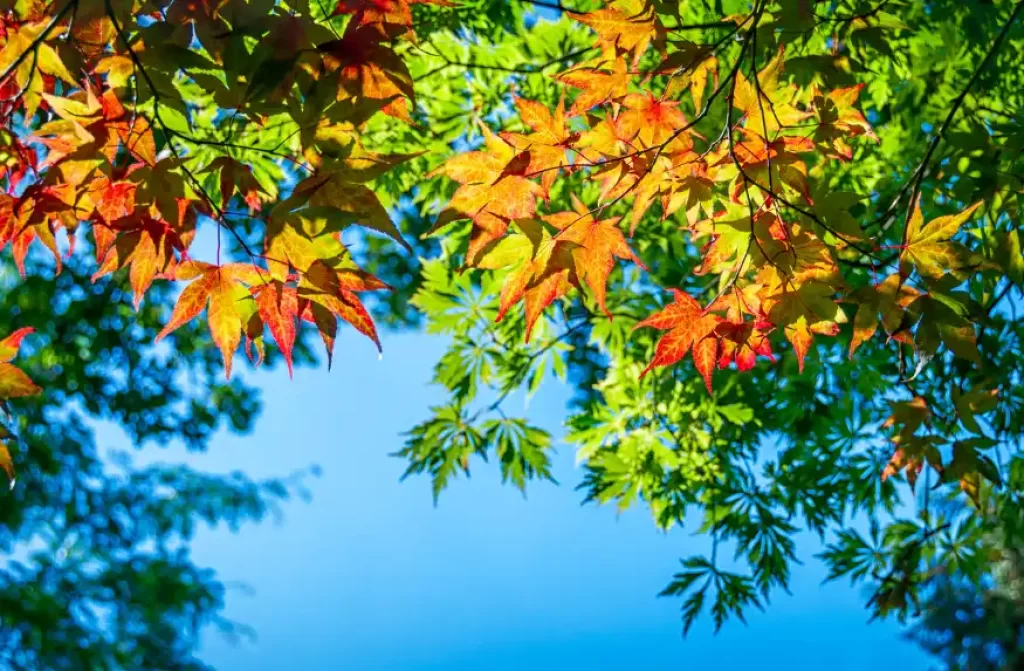
Japanese maples (Acer palmatum) are a popular choice for garden enthusiasts looking to add a touch of elegance and beauty to their outdoor space. With their unique characteristics, including vibrant colors, intricate leaf shapes, and stunning growth patterns, Japanese maples can be used in a variety of garden design ideas.
Different cultivars and variations of Japanese maple offer endless possibilities. From dwarf varieties suitable for small gardens or container planting to larger trees that provide shade and privacy, there is a Japanese maple cultivar for every garden style.
When planning your garden design with Japanese maples, it is crucial to consider the growing conditions required by these trees. They thrive in well-drained soil and prefer partial shade or filtered sunlight. Adequate watering and fertilizing are also essential for healthy growth.
Pruning and training techniques can help maintain the shape and size of your Japanese maple while promoting optimal health. However, it is vital to understand common pests and diseases that may affect your tree’s growth.
If you’re interested in propagating your own Japanese maple tree, several methods can be used depending on the cultivar type.
Incorporating Japanese maples into your garden design has many benefits beyond their aesthetic appeal. These trees can provide shade, attract wildlife, improve air quality, and increase property value.
In conclusion, adding a Japanese maple (Acer palmatum) to your garden design can elevate its beauty and create an elegant outdoor space. By considering the growing conditions required by these trees, utilizing pruning techniques when necessary, understanding common pests and diseases, propagating new trees if desired- you can enjoy all the benefits they bring!
Frequently Asked Questions
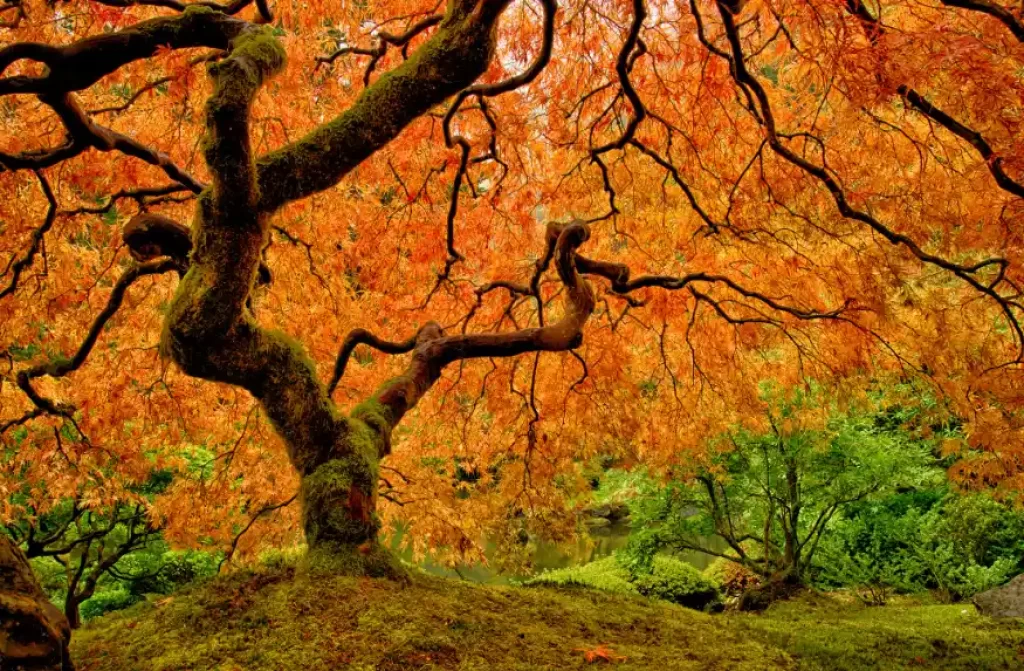
When should Japanese maples be planted?
The ideal time to plant Japanese maple trees (Acer palmatum) is during the dormant season, which is typically in late fall or early spring. This allows the tree to establish its root system before facing the stress of hot summer temperatures or freezing winter conditions.
Late fall, after the leaves have dropped, is a great time to plant Japanese maples because the tree is entering dormancy. The soil is still warm, which encourages root growth even as the tree remains inactive above ground.
Early spring, before new growth starts, is another suitable time to plant Japanese maples. Planting in early spring allows the tree to take advantage of the moist, cool conditions to establish its root system before the arrival of warmer weather.
It’s important to avoid planting Japanese maples during extreme weather conditions, such as the peak of summer heat or the height of winter frost. These conditions can stress the tree and impede its establishment.
Additionally, consider your specific climate and local weather patterns when determining the best time to plant Japanese maples. Consulting with local gardening resources or nursery professionals can provide further guidance based on your specific location.Why is my Japanese maple tree dying?
Several factors can cause a Japanese maple tree to die, including poor soil drainage, incorrect watering practices, pest infestations, diseases such as verticillium wilt or anthracnose, and environmental stressors like extreme heat or cold.
What Japanese maple is best for full sun?
While Japanese maples generally prefer partial shade or dappled sunlight, there are a few varieties that can tolerate and thrive in full sun conditions. Here are some Japanese maple cultivars known for their ability to handle full sun exposure:
- Acer palmatum ‘Bloodgood’: This is one of the most popular and widely planted Japanese maple varieties. It has deep burgundy foliage that retains its color well even in full sun.
- Acer palmatum ‘Emperor I’: This variety has vibrant red foliage that can tolerate full sun. It is known for its outstanding heat tolerance.
- Acer palmatum ‘Crimson Queen’: While it appreciates some shade during the hottest part of the day, ‘Crimson Queen’ can tolerate full sun if provided with sufficient moisture. It forms a cascading mound of finely dissected red leaves.
- Acer palmatum ‘Sango Kaku’ (Coral Bark Maple): This variety is prized for its bright red bark, which provides visual interest year-round. It can tolerate full sun but may benefit from some shade in hotter regions.
- Acer palmatum ‘Shishigashira’ (Lion’s Head Maple): This cultivar is known for its dense, compact growth and curled, crinkled leaves. It can tolerate full sun if the soil is consistently moist.
It’s important to note that even sun-tolerant Japanese maple varieties may still benefit from some protection during the hottest parts of the day, especially in regions with intense or prolonged sun exposure. Providing adequate soil moisture and mulching around the base of the tree can help keep the roots cool and retain moisture.
Where can I buy a Japanese maple tree?
You can purchase Japanese maple trees from local nurseries, garden centers, or online retailers. Make sure to choose a reputable seller and select a healthy-looking tree with good root structure.
When does a Japanese maple tree bloom?
Japanese maple trees, known botanically as Acer palmatum, are renowned for their beautiful foliage rather than their flowers. However, they can produce small and inconspicuous flowers in spring, typically around April to May, depending on the specific variety and location.
These flowers are often not the main attraction of Japanese maples, as their foliage steals the spotlight with its stunning colors and intricate shapes.
The vibrant foliage of Japanese maples typically emerges in spring and can transform into shades of red, orange, yellow, or purple, depending on the cultivar, adding a remarkable display to the landscape.







